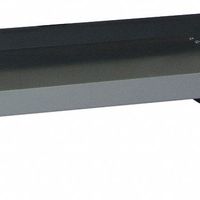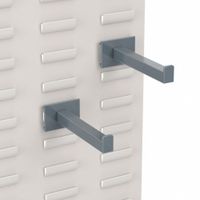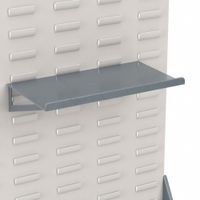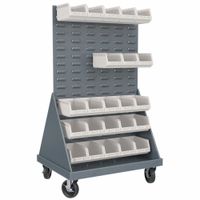Call +(254) 703 030 000 / 751 483 999 / 721 704 777
- Home
- Material Handling
- Storage Workspace
- Storage Panels Panel Racks
- Louvered Panels Racks Accessories
.....Read More
Frequently Asked Questions
What are louvered panels and racks used for?
Louvered panels and racks are organizational tools used primarily for storage and efficient space management in various settings, including industrial, commercial, and residential environments.
Louvered panels are typically wall-mounted or free-standing panels featuring a series of horizontal slats or "louvers." These panels are designed to hold bins, containers, or hooks, allowing for the easy organization and accessibility of small parts, tools, or supplies. They are commonly used in workshops, garages, warehouses, and retail spaces to keep items visible and within reach, reducing clutter and improving workflow efficiency. The modular nature of louvered panels allows for customization, enabling users to configure storage solutions tailored to their specific needs.
Racks, on the other hand, are structures designed to hold or support items, often in a vertical arrangement. They come in various forms, such as shelving units, pallet racks, or cantilever racks, and are used to store larger or bulkier items. Racks maximize vertical space, making them ideal for environments where floor space is limited. In warehouses, racks are essential for inventory management, allowing for the systematic storage and retrieval of goods. In retail settings, they display products in an organized manner, enhancing customer experience.
Both louvered panels and racks contribute to improved organization, increased storage capacity, and enhanced operational efficiency. They help in maintaining a tidy environment, reducing the time spent searching for items, and minimizing the risk of damage or loss. By optimizing space and ensuring easy access to stored items, these storage solutions support productivity and streamline processes across various applications.
How do louvered panels and racks work with plastic hanging bins?
Louvered panels and racks are designed to organize and store small parts efficiently using plastic hanging bins. These systems work by providing a sturdy, vertical surface with horizontal slats or "louvers" that allow bins to be securely attached and easily accessed.
The louvered panels are typically made of metal and feature rows of evenly spaced louvers. Plastic hanging bins are designed with a lip or hook on the back that fits into these louvers. When the bin is hung on the panel, the lip slides into the louver, holding the bin in place. This setup allows for quick attachment and removal of bins, facilitating easy reorganization and access to stored items.
Racks, on the other hand, are freestanding or mobile units that incorporate louvered panels. They offer the same functionality as wall-mounted panels but provide additional flexibility in terms of placement and mobility. Racks can be moved to different locations as needed, making them ideal for dynamic work environments.
The combination of louvered panels or racks with plastic hanging bins maximizes storage efficiency by utilizing vertical space. This system allows for clear visibility and easy access to stored items, which is crucial for inventory management and workflow efficiency. The bins come in various sizes and colors, enabling customization based on the specific needs of the user, such as sorting by size, type, or frequency of use.
Overall, louvered panels and racks with plastic hanging bins offer a versatile, space-saving solution for organizing small parts, tools, and supplies in workshops, warehouses, and other industrial or commercial settings.
Can louvered panels and racks be customized or reconfigured?
Yes, louvered panels and racks can be customized or reconfigured. These storage solutions are designed to be versatile and adaptable to various organizational needs. Customization can involve altering the size, shape, or material of the panels and racks to fit specific spaces or requirements. This can include adjusting the dimensions to fit a particular wall or area, or choosing materials that match the aesthetic or functional needs of the environment, such as stainless steel for durability or powder-coated finishes for aesthetic appeal.
Reconfiguration is another key feature of louvered panels and racks. They often come with modular components that allow users to rearrange bins, hooks, or shelves to suit changing storage needs. This flexibility is particularly useful in environments where inventory or storage requirements frequently change, such as in warehouses, workshops, or retail spaces. Users can easily add, remove, or reposition components without the need for specialized tools or expertise.
Additionally, many manufacturers offer a range of accessories and add-ons, such as different types of bins, hooks, and shelves, which can be integrated into the existing setup. This allows for further customization and optimization of storage solutions. Some systems also offer color-coding options to enhance organization and efficiency.
Overall, the ability to customize and reconfigure louvered panels and racks makes them a highly adaptable and efficient storage solution for a wide range of applications.
What are the benefits of using mobile louvered racks?
Mobile louvered racks offer several benefits, enhancing storage efficiency and organization:
1. **Space Optimization**: These racks maximize vertical space, allowing for more storage in a smaller footprint. Their mobility enables easy reconfiguration to adapt to changing storage needs.
2. **Enhanced Organization**: Louvered racks provide a structured system for storing items, often using bins or containers that can be easily labeled and accessed. This organization reduces clutter and improves inventory management.
3. **Accessibility and Convenience**: The mobility of these racks allows users to move them to different locations as needed, providing easy access to stored items. This is particularly beneficial in dynamic environments where storage needs frequently change.
4. **Durability and Stability**: Typically made from robust materials like steel, louvered racks are designed to withstand heavy loads and frequent movement, ensuring long-term use and reliability.
5. **Versatility**: These racks can accommodate various types of storage bins and containers, making them suitable for diverse applications across industries such as manufacturing, retail, and healthcare.
6. **Improved Workflow**: By organizing tools, parts, or products efficiently, mobile louvered racks streamline workflows, reducing the time spent searching for items and increasing productivity.
7. **Cost-Effectiveness**: Investing in mobile louvered racks can be more economical than expanding physical storage space. Their adaptability and durability also mean lower maintenance and replacement costs over time.
8. **Safety and Ergonomics**: Properly organized storage reduces the risk of accidents and injuries. The mobility feature allows users to bring items closer to their work area, minimizing the need for excessive bending or reaching.
9. **Aesthetic Appeal**: A well-organized storage system enhances the overall appearance of a workspace, contributing to a professional and efficient environment.
How do you install stationary louvered panels and racks?
1. **Planning and Preparation**: Measure the area where the louvered panels and racks will be installed. Ensure you have the correct size and number of panels and racks. Gather necessary tools such as a drill, screws, level, measuring tape, and a pencil.
2. **Marking the Installation Area**: Use a pencil and level to mark the positions on the wall or surface where the panels and racks will be mounted. Ensure the markings are level and evenly spaced.
3. **Installing the Mounting Brackets**: If the panels come with mounting brackets, attach them to the wall using a drill and appropriate screws. Ensure the brackets are level and securely fastened.
4. **Attaching the Panels**: Align the louvered panels with the installed brackets or directly to the wall if no brackets are used. Secure the panels using screws, ensuring they are tightly fastened and level.
5. **Installing the Racks**: If the racks are separate from the panels, attach them to the panels or directly to the wall, depending on the design. Use screws to secure them in place, ensuring they are level and can support the intended weight.
6. **Final Adjustments**: Check the alignment and stability of the panels and racks. Make any necessary adjustments to ensure they are securely installed and functioning as intended.
7. **Clean Up**: Remove any debris or dust from the installation area. Ensure all tools and materials are stored properly.
8. **Safety Check**: Verify that all components are securely fastened and that the installation is safe for use.
What types of accessories are compatible with louvered panels and racks?
Louvered panels and racks are versatile storage solutions commonly used in industrial, commercial, and even residential settings. They are designed to accommodate a variety of accessories that enhance organization and accessibility. The compatible accessories include:
1. **Bins and Containers**: These are the most common accessories used with louvered panels. They come in various sizes, colors, and materials, such as plastic or metal, and are designed to hang securely on the louvers. They are ideal for storing small parts, tools, and components.
2. **Hooks and Pegs**: These accessories are used to hang tools, equipment, or other items directly on the panel. They come in different shapes and sizes to accommodate various items, from hand tools to larger equipment.
3. **Shelves**: Some louvered panels and racks can be fitted with shelves, providing a flat surface for storing larger items that cannot be hung or placed in bins.
4. **Label Holders**: These are used to organize and identify the contents of bins or the items on hooks. They can be attached directly to the bins or the panel itself.
5. **Dividers**: Used within bins, dividers help in organizing and separating different items within the same container, enhancing the storage system's efficiency.
6. **Tool Holders**: Specialized holders for specific tools, such as screwdrivers or pliers, can be attached to the panels, providing easy access and organization.
7. **Wire Baskets**: These are used for storing larger or bulkier items that do not fit into standard bins or containers.
8. **Magnetic Accessories**: Some panels can accommodate magnetic accessories, such as magnetic tool holders or trays, for additional storage options.
These accessories make louvered panels and racks highly adaptable, allowing for customized storage solutions tailored to specific needs.
How do you maintain and clean louvered panels and racks?
To maintain and clean louvered panels and racks, follow these steps:
1. **Regular Dusting**: Use a microfiber cloth or a duster to remove dust from the panels and racks. This should be done weekly to prevent dust accumulation.
2. **Vacuuming**: Use a vacuum cleaner with a brush attachment to remove dust and debris from hard-to-reach areas. This is especially useful for louvered panels with intricate designs.
3. **Washing**: For deeper cleaning, mix a mild detergent with warm water. Use a soft cloth or sponge to gently wash the surfaces. Avoid soaking the panels or racks, as excessive moisture can cause damage.
4. **Rinsing**: After washing, use a clean, damp cloth to wipe away any soap residue. Ensure that no detergent is left on the surfaces, as it can attract more dirt.
5. **Drying**: Use a dry, soft cloth to thoroughly dry the panels and racks. This prevents water spots and potential rusting, especially on metal surfaces.
6. **Polishing**: For wooden louvered panels, apply a suitable wood polish to maintain their finish and protect against moisture. For metal racks, consider using a metal polish to prevent tarnishing.
7. **Inspection**: Regularly inspect the panels and racks for any signs of damage, such as rust, loose screws, or chipped paint. Address these issues promptly to prevent further deterioration.
8. **Lubrication**: If the panels or racks have moving parts, apply a light lubricant to hinges or joints to ensure smooth operation.
9. **Avoid Harsh Chemicals**: Do not use abrasive cleaners or harsh chemicals, as they can damage the finish and integrity of the panels and racks.
10. **Protective Measures**: Consider using protective covers or placing the panels and racks in areas less exposed to direct sunlight or moisture to prolong their lifespan.




